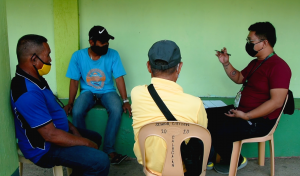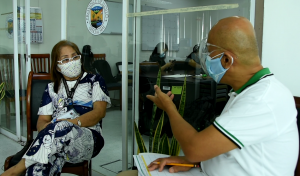 he CMT is one of the PRDP tools devised to aid the citizens in monitoring PRDP FMR subprojects in view that their participation as monitors will increase their ownership to the project for its efficiency and sustainability.
he CMT is one of the PRDP tools devised to aid the citizens in monitoring PRDP FMR subprojects in view that their participation as monitors will increase their ownership to the project for its efficiency and sustainability. PRDP conducts CMT assessment among select project sites in Western Visayas

Ramoncito S. Lopez, Barangay Charmain of Tinocuan, Dueñas, Iloilo, says they were given the ‘right knowledge in monitoring the road in order to make use of it for a long time.’ To him, their first site visit was remarkable for it is where he has learned the exact construction procedure, what materials to be used just as the kind of gravel to be mixed with the cement and what sizes of stones to be used in order to have a quality output.
In view to reaffirm citizens’ involvement in monitoring the subprojects of the Department of Agriculture’s Philippine Rural Development Project (DA-PRDP) and to pilot knowledge harvesting for Citizens Monitoring Tool (CMT) as one of its distinct tools, the Regional Project Coordination Office 6 (RPCO 6) and Project Support Office (PSO) Visayas conducted actual interviews with the CMT participants from the selected project sites in Aklan, Guimaras, and Iloilo.
The Monitoring and Evaluation (M&E) Unit spearheaded the activity alongside the Social and Environmental Safeguards (SES) and InfoACE Units. CMT participants were consulted on the extent of their involvement in the monitoring of the subproject processes of the PRDP through a designated questionnaire prepared for the local government units and barangay implementing teams (BITs).
“Our local stakeholders are the recipients of the project. They are the ones who will enjoy it later so they should know what the project is and what they are receiving,” said Franco Villaruel, M&E Unit Head of PSO Visayas.
“In order for them to play such role, we are conducting the CMT training. They are being taught of the measurement, technical terms, and other significant aspects with regards to the project construction. This fortunately sparked a high level of interest among them as it was their primary experience,” he added.
Meanwhile, he emphasized that the CMT does not conclude with the training. Assessments are being conducted in order to check whether the participants have been actually applying those that they have learned with the construction of the Farm-to-Market Roads (FMRs) in their respective provinces.
“They have become our eyes, ears, and mouth into the project sites and in the community- our extension per se. Thus, their role is truly important to channel and address all the concerns in line with our projects,” Villaruel stressed.
 “Our local stakeholders are the recipients of the project. They are the ones who will enjoy it later so they should know what the project is and what are they receiving,” said Franco Villaruel, M&E Unit Head of PSO Visayas.
“Our local stakeholders are the recipients of the project. They are the ones who will enjoy it later so they should know what the project is and what are they receiving,” said Franco Villaruel, M&E Unit Head of PSO Visayas.
Barangay Chairman of Bugnay, Jordan, Guimaras, Mary Jean Capalla, shared how they were able to apply all the learnings they acquired from the training during the actual project implementation in their area.
“Through our cooperation, we were able to utilize the knowledge on CMT from the training we have attended before. We do continuous monitoring during the road construction and in our barangay assembly, we discuss all the matters at hand regarding the project as well as we echoed the basics of CMT among our members in order to give them light about the importance of monitoring.”
Moreover, Ramoncito S. Lopez, Barangay Charmain of Tinocuan, Dueñas, Iloilo, stated that they were given the ‘right knowledge in monitoring the road in order to make use of it for a long time.’ To him, their first site visit was remarkable for it is where he has learned the exact construction procedure, what materials to be used just as the kind of gravel to be mixed with the cement and what sizes of stones to be used in order to have a quality output.
On the part of the local government units, the employment of CMT has also been beneficial in scaling up community participation during the implementation of the project. According to Josie Abonador, Municipal Planning Development Coordinator of Dueñas, Iloilo, the training became a way to empower and mobilize the entire community that would benefit from the project.
“Right after the training, we requested the nine project affected barangays to convene and informed them about the project along with their responsibilities as barangay beneficiaries. Generally, our thrust is centered on cultural development focusing on agricultural advancement so this yielded positive responses among them. By then, we prepared resolutions to create the team for monitoring which later on, they performed their duties in consonance when the project construction started.”
As to Albert Cordero, Engineer II of the Provincial Engineering Office of Guimaras, the CMT allowed them to identify issues and consequently to take necessary actions relevant to the project.
“One of the important things we learned from the training is that CMT is vital and needed in every project aside from the implementers and contractors. It is essential in checking and verifying if all the deliverables were executed properly by the contractor,” said Cordero.
Also, Cordero set one of the examples where the CMT was being utilized in the actual implementation of the PRDP project in their place.
“As per monitoring during the project implementation of FMR through checking the finished physical activities, we were able to find some defects and raised them immediately to the project implementor and contractor wherein they also addressed readily.”
As point of reference for each province, the CMT assessment were done for the various PRDP subprojects in the region, namely: Rehabilitation of 4.197-kilometer Lalab-Bay-ang- Magpag-ong FMR in Batan, Aklan; Rehabilitation of the 28-kilometer Imbang Grande-Tagubong, Gemuma Agahaon- Agtabo FMR in Passi City, Iloilo, the longest FMR subproject in the region as to date; Improvement/Rehabilitation of 10.87-kilometer Bugnay-Sapal-Maabay FMR covering the Jordan, San Lorenzo, and Sibunag towns in Guimaras, and Rehabilitation/Concreting of the 9.9-kilometer Tinocuan-Maribuyong FMR in Dueñas, Iloilo, respectively.
The CMT is one of the PRDP tools devised to aid the citizens in monitoring PRDP FMR subprojects in view that their participation as monitors will increase their ownership to the project for its efficiency and sustainability. Furthermore, through the assessment conducted, PRDP aims to establish a comprehensive CMT profile that contains data and information which can be used as basis in the analysis on the functionality and effectiveness of employing the said tool for its FMR subprojects. (April Grace Padilla, RPCO 6, Writer)
